Boards of directors are elected by the company’s shareholders to supervise their company’s key officers. As such, for many, becoming a corporate director exemplifies a pinnacle career accomplishment.
At least lately, however, the reality of being a corporate director varies considerable with its long-standing perceptions. The perception of a corporate director is one of glamour: Holding multiple hugely lucrative director positions simultaneously, hopping on private jets for periodic and fairly unchallenging meetings in luxury locations.
But that perception, if it was ever reality, is certainly not the reality of today as our database of organizational charts reveals.
For over a decade, we have diligently assembled and maintained updated organizational charts for the world’s 80,000 largest companies.
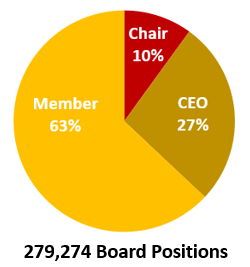
These organizational charts include 279,274 board positions split between three corporate director positions: board chairs, chief executive officers (CEOs), and board members.
1. Are most board positions held by only a few people?
No. Nine out of ten board members (88 percent) hold just one single board affiliation.
Reason: The broad and serious fiduciary responsibilities of today’s board combined with the increasingly fast pace at which most companies operate and compete have made the prospect of holding multiple board affiliations much less feasible than in years past.
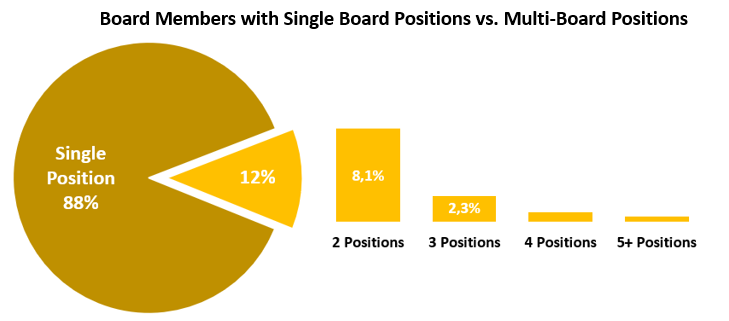
This is proving true even for the brightest business leaders.
Prominent example: Timothy Cook, who has served as CEO of Apple Inc. (NASDAQ : APPL) since 2011, is director of only two publicly-traded companies: As CEO at Apple, he logically serves on the Apple board. He additionally serves as a director of Nike, Inc. (NYSE: NKE).
Overall, of the total board members on the world’s 80,000 largest corporations, only 0.5 percent hold five or more directorships. Our database reveals the record for directorships is held by a man in Indonesia, who serves on 16 boards simultaneously.
Among all board memberships, executives holding five or more memberships (1,209 persons in total) most commonly are partners at large venture capital funds or at private equity firms. Their board memberships are part of their core executive mission of supervising and developing return on their investors’ money predominantly at smaller medium-sized companies.
Two prominent examples are Ben Horowitz or Mark Andressen, the co-founders and general partners of venture capital firm Andressen Horowitz. In this capacity, they each hold over ten board positions, but each are on the boards of medium-sized private firms.
2. Where are most multi-board positions located?
Cumulatively, according to our database, 27,866 multi-board members hold 69,583 board positions (out of our total of 279,274 board positions).
Regardless of their number of board positions, their multi-board memberships are in companies from different industries:

These multi-board memberships are located mostly in companies registered in the same country:
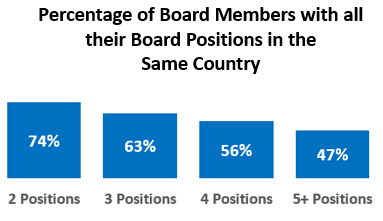
Why are multi-board members typically affiliated with companies based in the same country?
Multi-board members must understand the corporate regulatory requirements of the companies on whose boards they serve, and those regulations differ considerably from country to country (e.g., U.S. vs. Germany vs. Japan or France).
Additionally, with boards now meeting more frequently than in years past (now typically in excess of five times annually), travel and meeting obligations make it increasingly impractical to hold a significant number of board affiliations simultaneously.
At the same time, directors are constrained by non-compete clauses that often restrict their ability to serve on multiple boards within the same industry.
3. Do large company boards have more multi-board members?
Yes!
We consider “large” companies to be those that belong to major indices such as the S&P 500, Stoxx 600, Russell 3000, Global Forbes 2000, Global Fortune 500, or to be unicorns that are privately-held startup companies valued at over $1 billion (download the six lists).
Altogether, these 5,559 large companies are supervised by 69,583 board positions.
Among S&P 500 companies and other large companies, 99 percent have at least one multi-board member. Among the 80,000 companies in our global sample, only one third (34 percent), on average, have at least one multi-board member:

Among large companies, 42 percent to 63 percent of board members, on average, are multi-board members versus 25 percent for our entire database sample of 80,000 companies.
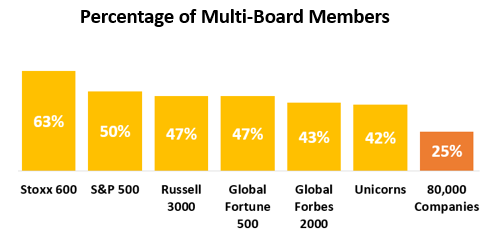
These 5,559 large companies are thus super-connected through their 12,496 multi-board members.
Why? Board members at large companies hold complex and increasingly demanding functional responsibilities that require expertise and involve multiple responsibilities to multiple stakeholders. As such, seasoned board members with positive reputations are typically preferred for these board positions.
4. Do board members also hold non-CEO executive positions?
Rarely. According to our database, only 2.5 percent of current single board members hold a non-CEO executive position:
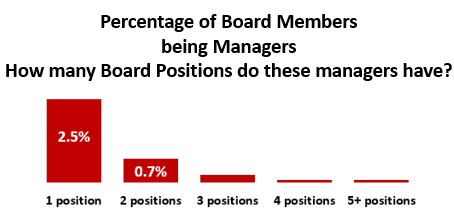
Of these 8,648 non-CEO executives holding at least one board position, the majority (71 percent) hold general management or finance roles. Among technical executives, most are found in Medical, IT, Engineering, and R&D.

5. Where are these board roles located?
Globally. Nine positions out of ten are located at companies registered in North America, Europe, or Asia. The most represented industries are Finance, Manufacturing, Service and Technology.

Take-aways
Among medium/large companies, nine out of ten board members hold just one single board assignment. Among our total 279,274 board positions, very few board members simultaneously hold a senior non-CEO management position.
Among our 279,274 total board positions, less than ten percent (27,866) are multi-board members globally.
Establishing and maintaining contact with these highly-connected members of multiple boards, of course, can be hugely pivotal for consulting, advisory and recruiting firms or for companies and executive search firms seeking to fill new senior board positions.